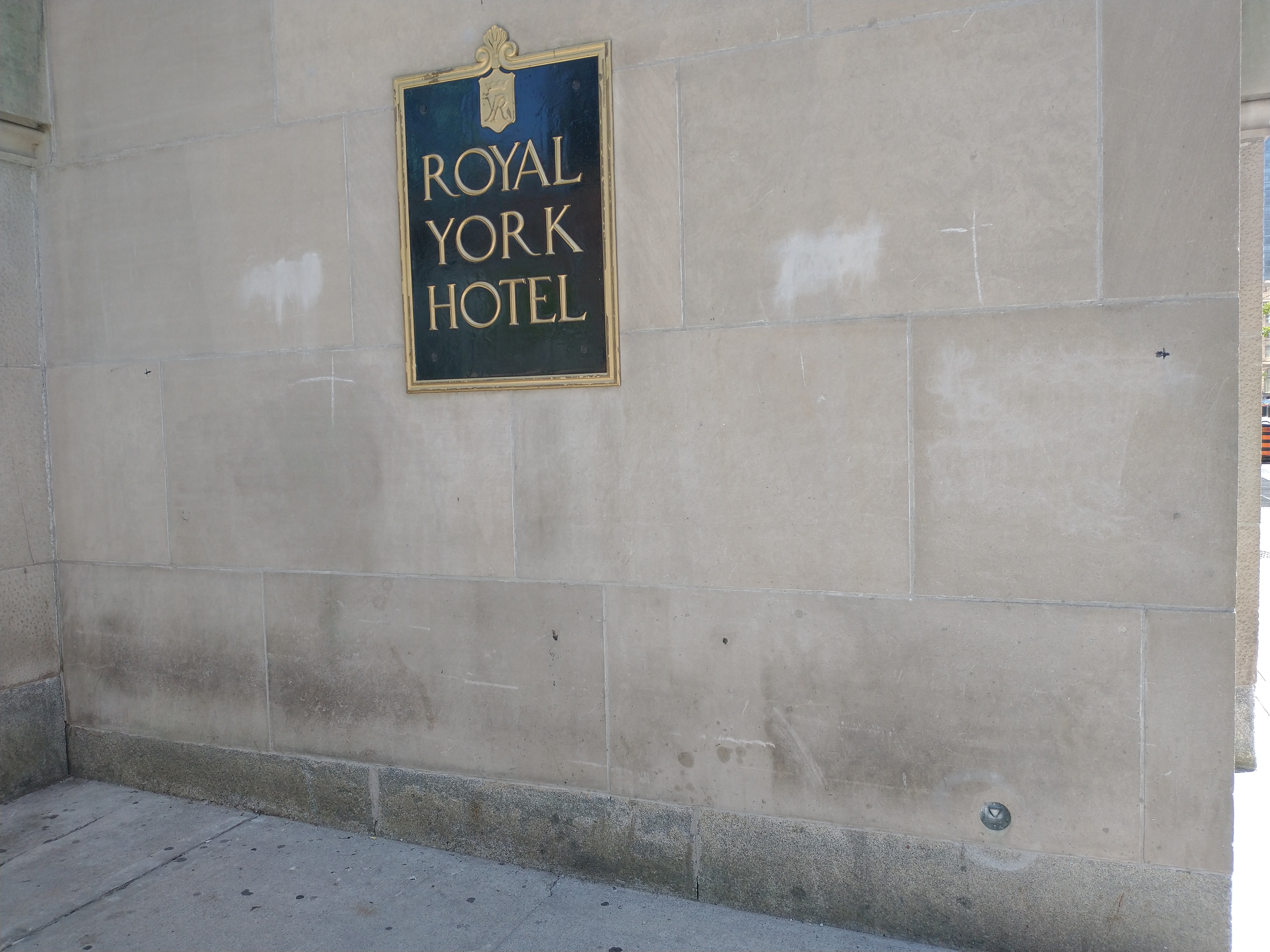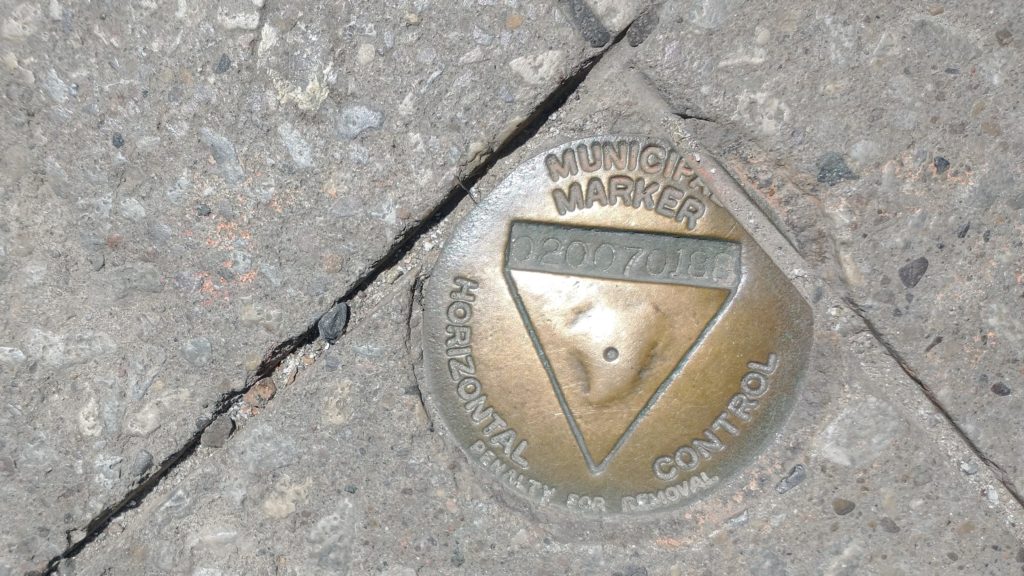I have a new obsession: survey monuments.
It started a couple of weeks ago. I was on my way to Roy Thomson Hall for a concert of the Toronto Symphony Orchestra. As I waited on the corner to cross at Front and Simcoe, my eye was caught by a metallic, shiny something at the edge of the sidewalk. My first flash of awareness was dominated by a pattern of triangles and circles. “Something Masonic?” I thought. I had enough time to read “Municipal Marker” etched into the bronze disc before the light changed and I continued on my way.
A few days later, as I was sitting at home drinking my morning coffee, the memory came back to me. So I did what most of us would do: I pulled out my phone and started entering search terms in Google. And I discovered a secret system hidden in our sidewalks: the world of survey monuments.
Survey monuments come in a variety of forms, not only bronze, official-looking discs set into sidewalks and walls, but they can also be as simple as crosses etched into the concrete or nails in the road. They serve a variety of purposes, but they all have this in common: they are part of an official system of registered survey benchmarks, and if you mess with them you can get in big trouble – like big trouble, as in jail time.
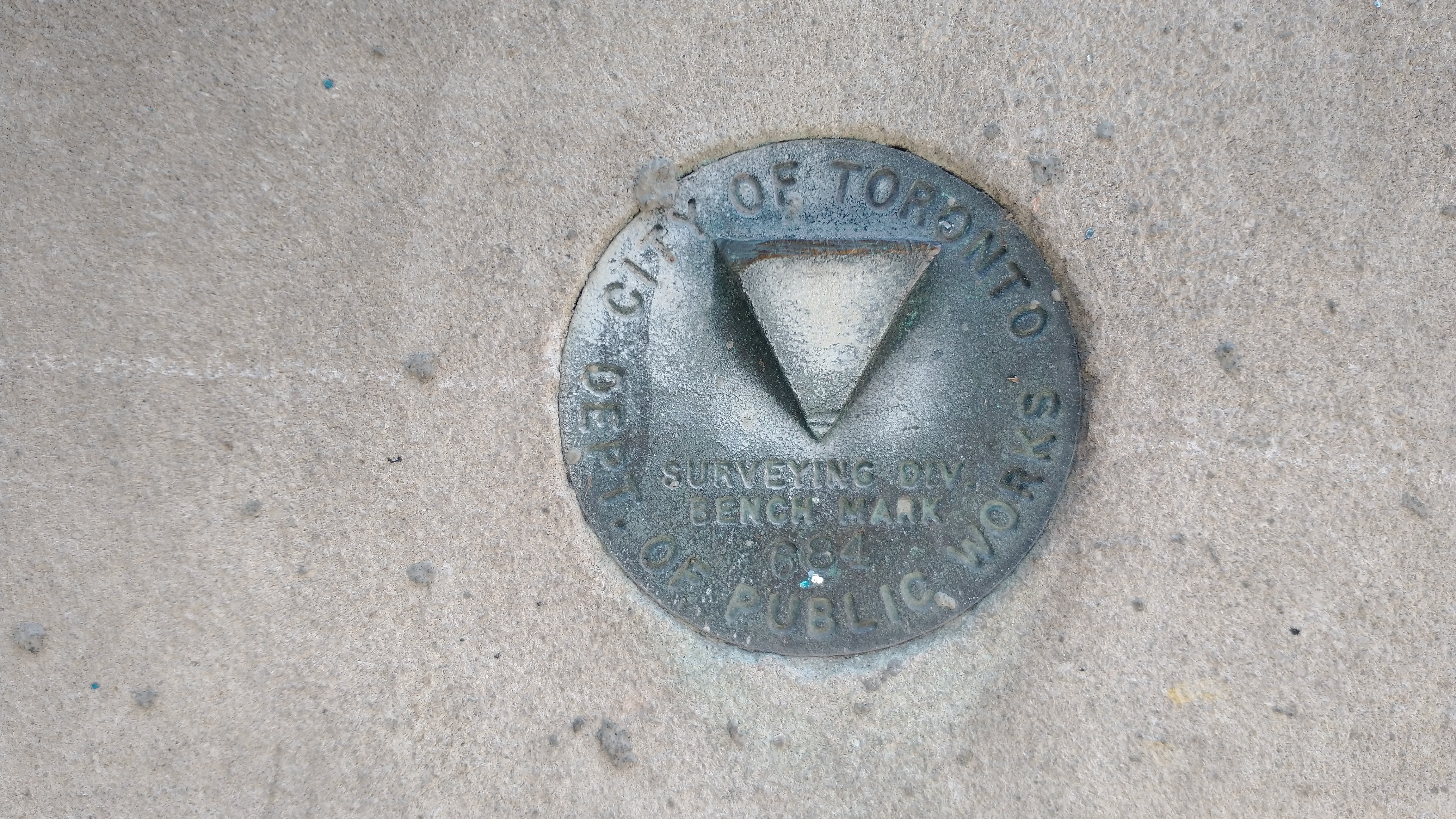
Generally speaking, there are two types of survey monuments: control monuments and property monuments. The control markers, like the bronze disc I saw at Front and Simcoe, are part of a vast network of horizontal and vertical markers throughout the city and the country, which surveyors use in their work as reference points.
Property monuments are much more common since they mark boundaries between one property and another or between public and private land. These come in a variety of shapes and sizes, though the ones I’ve seen in Toronto so far are crosses cut into the sidewalk and nails (often with the letters MAG stamped on the heads to indicate that they are magnetic, making them easier to find).
I was intrigued. And since it was a nice day out, I thought I would go survey monument hunting.
I didn’t have to travel as far as I had thought. In fact, I spent a couple of hours just wandering within a handful of city blocks noting all the markers I’d blithely walked over for years.
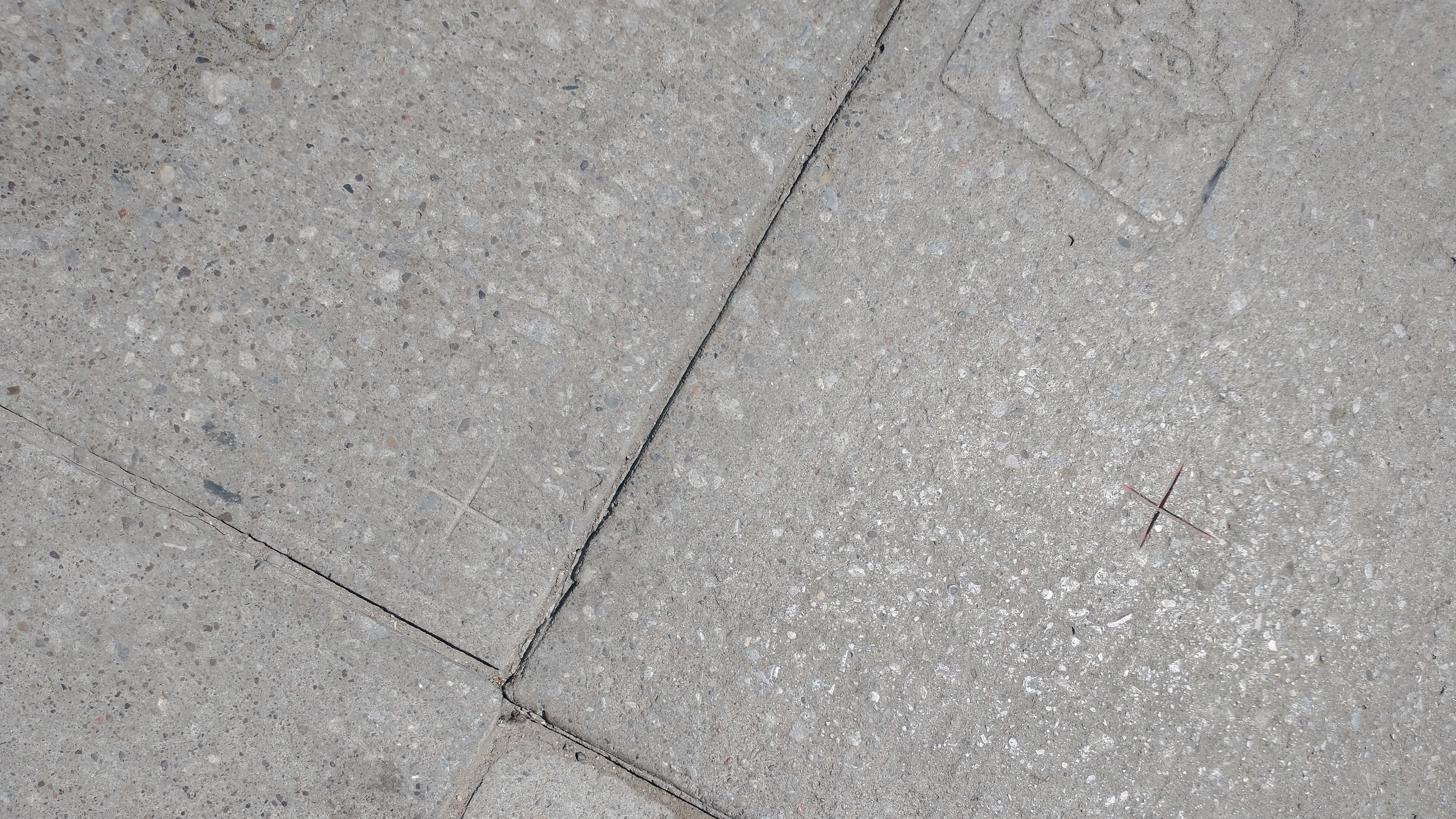
When I started out, I didn’t know precisely what I was looking for, so it took me a little bit to get my eye in. Plus, it was fairly late in the morning when I left home, and as any archaeologist will tell you, it’s easier to see markings in raking light, so the direct light of the noonday sun made my task a little harder. But I didn’t mind. It just meant more crouching down to get a better look and maybe even feel. Is that a deliberate marking in the sidewalk or just an optical illusion?
To my surprise, I managed to attract some attention. I’m used to thinking of Toronto as a place where you’re often likely to find strange people doing strange things and people just don’t notice. But an ordinarily-dressed woman looking for something on the sidewalk, I guess that’s just one step too weird for Toronto. Twice I noticed people watching me from a safe distance and slowly moving on once I’d spotted them. Another time, a man made his vehicle honk at me when I had wandered too close to the curb. (I guess when you have things you worry that someone will take them from you – even if it’s only a burgundy minivan.) But most people just gave me strange looks as they hurried past on their way to lunch. (I note, too, that despite all the attention, not a single person asked me what I was looking for or whether I needed help. Make of that what you will.)
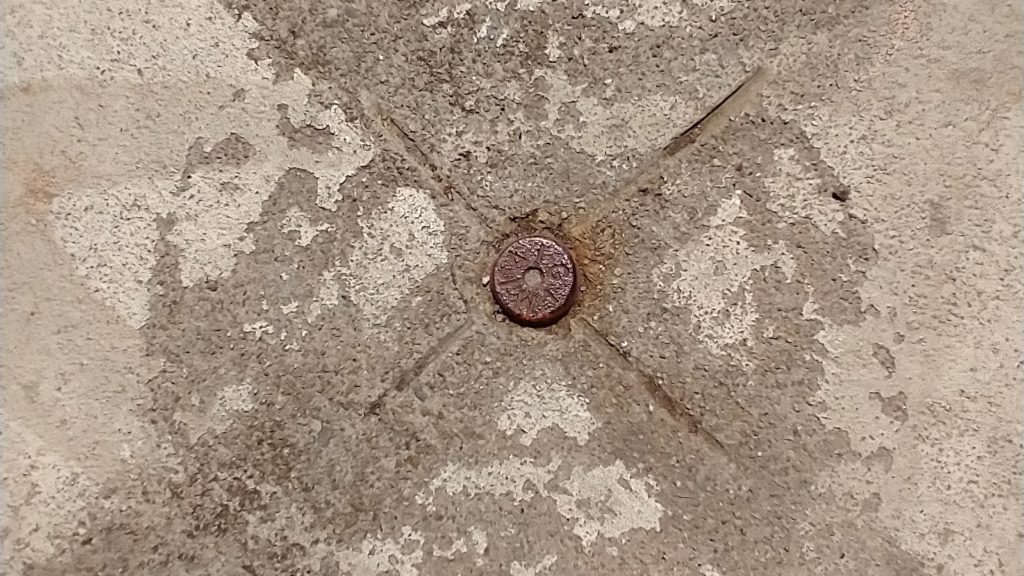
The more important effect of that little outing is that it has made me much more aware of my surroundings. I was amazed at just how many survey monuments there are within a fairly narrow radius and which I had never even noticed before! For example, there is one on a pillar at Scotiabank Arena, which I often pass on my way to Union Station, and I only just noticed it the other day. And astonishingly, though many are also marked out with spray paint, making them even more visible for surveyors and other workers, perhaps, I still never saw them. Now as I walk through the city, I see them everywhere. It can be a little overwhelming at times.
As I walked along keeping an eye out for survey monuments, I began to notice other details, too: a line of narrow iron bars bleeding rust into the concrete (apparently, there used to be a fence here), a series of hollow posts razed at ground level (former bike racks?), and many other markings from times gone by of which I could make no immediate sense. But they gave me a strange and unexpected feeling of groundedness.
I had a similar feeling when I discovered that survey monuments provide the most important and reliable evidence of property lines. Not what’s written on some sheet of paper or recorded in some database but the actual physical mark on the earth. Mark Zuckerberg may believe that we’re headed toward a future in which the virtual realm will supplant the physical, but we are not there yet!
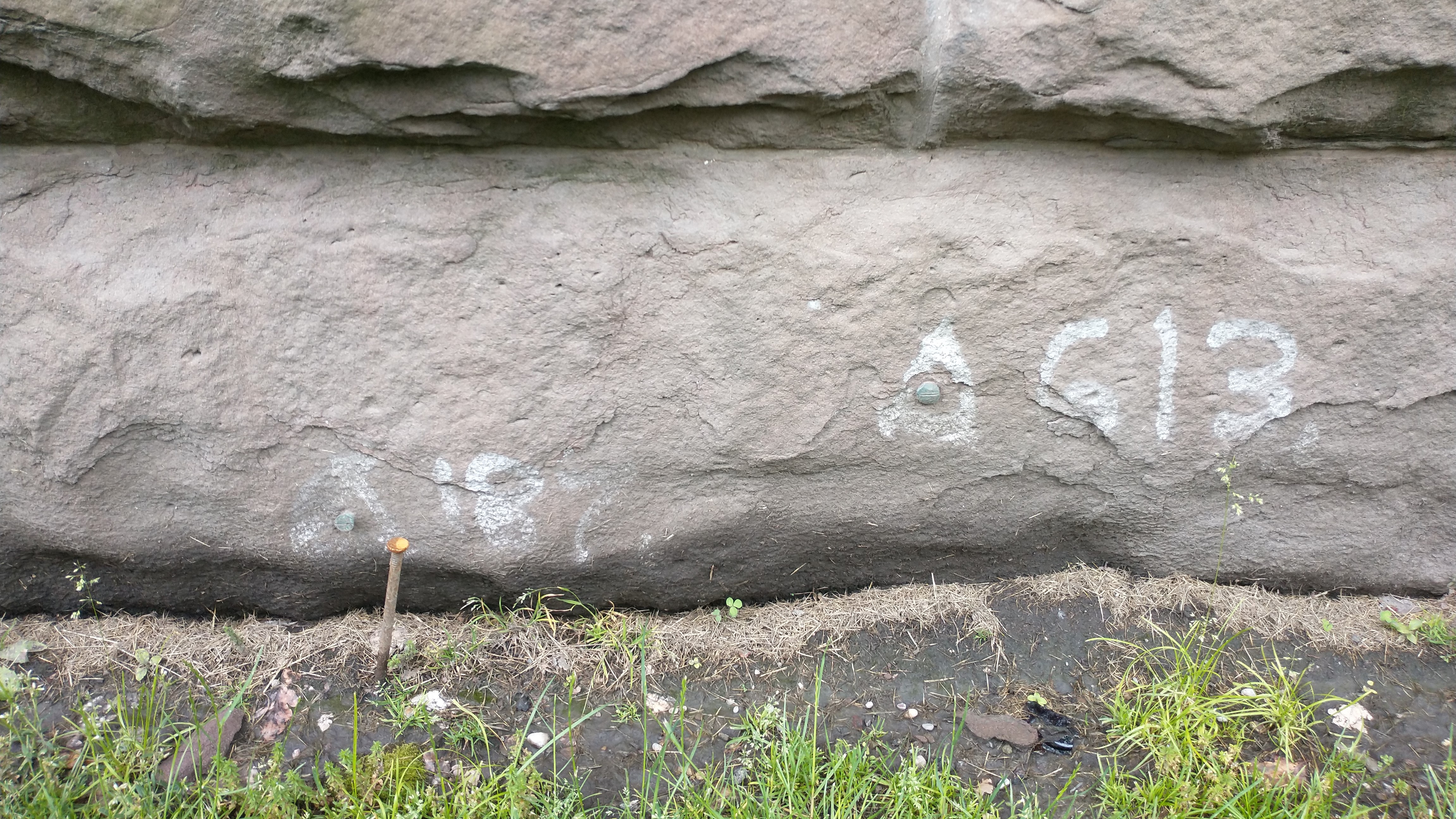
It’s hard to say, though, why exploring survey monuments produced in me this sudden sense of being grounded in reality and in the city. Perhaps it’s because it made me think about each space in a more attentive way. Rather than rushing past, always on my way to somewhere else, I suddenly considered that each small corner of the city has its own life, its own history. And the very physical marks of that history remain embedded in the city. Or perhaps it’s because so much of my life takes place in the ether these days that to really look at the details of the world around me was refreshing for my consciousness and my awareness of place.
I am a person who prefers to be present to the place where I am (not staring at a screen or listening to the soundscape of my choosing), so it was also sobering to realize how much of the world around me I really don’t see. At the same time, however, we do have limits. It’s no wonder I’ve missed survey monuments on street corners, as I’m usually watching for lights and traffic and fellow pedestrians. It’s telling that I noticed the marker at Front and Simcoe while I was standing still.
Once when I was walking the Camino de Santiago in Spain, a fellow pilgrim told me about his efforts to be more mindful and aware – even to the level of noticing the feel of the ground under his feet. Cultivating that level of awareness is something we can do even in our ordinary, everyday lives in the middle of downtown Toronto or wherever we happen to live. We think we know the places where we live and so we tune them out. But perhaps if we were more aware, we would start to notice things we’ve never seen before and learn to experience the reality of our everyday lives in a different and more grounded way.
